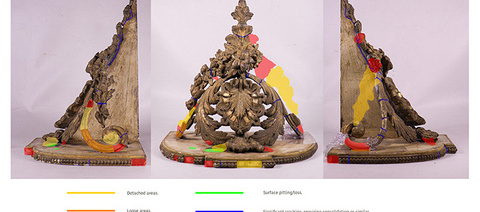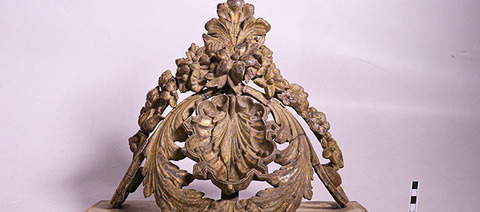Gilt Wall Bracket
Conservation treatment of a singular gilt wall bracket constructed of a wire armature, composition decoration, wooden shelf and painted and gilded decorative surface. Degradation to various components affected the stability and visual values of the object and suitable treatment was carried out in protection the object. The following treatment aims were identified and achieved:
• Stabilising of the main structure and re-attachment of loose components
• Replace missing components sympathetically
• Ensuring the historic and aesthetic values were not compromised
• Treated to standard suitable for decorative display
What was the goal the project set out to achieve?
The main treatment aim was to ensure the bracket would be stable for decorative use. To that end the loose and damaged components of the object needed to be secured, with significant losses impacting the visual values of the object also needing to be addressed. The degraded surface decoration was challenging to treat as it was unknown whether this was the appeal in purchasing the object at auction or whether a full re-gilding was intended. General cleaning was also required.
Documentation including visual and written records were carried out, as well as COSHH and risk assessments. This involved a treatment proposal, report and laboratory card.
What did I do?
General cleaning involved mechanical, solvent and gel methods. Prior to this consolidation was required in several areas using Paraloid B72 in acetone or isinglass in deionised water depending on the area of treatment. Soft bristle brushes and a dust blower removed the loose dirt and dust. After solvent testing, acetone was used to remove surface grime, and gel cleaning followed with tri-ammonium citrate in distilled water to further remove built-up dirt and grime whilst reducing the amount of moisture applied.
Areas of surface denting and loss to the shelf were filled/replaced with gesso putty and colour matched to the surrounding areas. The wire armature was consolidated and loose pieces of composition reattached using Paraloid B72 in acetone with glass microballoons which were also coloured matched.
Areas of significant loss to the decoration required replacement owing to the object's visual values. Wax models were carved and molds made from these with liquid latex. Final casts were either made from composition or Jesmonite AC300 depending on the area being replaced, and complexity of mold shape. After adhering to the main structure the casts were coloured matched to the surrounding areas.
What was the outcome?
A successful treatment ensured the wall bracket was stable for decorative use. All loose components were reattached and stabilised to the armature frame, with losses replaced with sympathetic materials and colour matching to suit the current decorative finish of the object.
What did I learn?
Combining multiple ethical positions together to develop a movement forward suitable for the object, but taking interventive steps for the structural issues, but considering a preserve as found ethics for the decorative surfaces.
Working on an object constructed of multiple materials including wood, metal, composition and decorative surfaces meant considering how to develop a holistic treatment which could stabilise the object for use, but ensure the aesthetic values were not compromised. Multiple ethical routes were explored in how best to address these issues.


